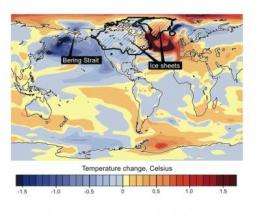Climate conditions in 2050 crucial to avoid harmful impacts in 2100

While governments around the world continue to explore strategies for reducing greenhouse gas emissions, a new study suggests policymakers should focus on what needs to be achieved in the next 40 years in order to keep long-term options viable for avoiding dangerous levels of warming.
The study is the first of its kind to use a detailed energy system model to analyze the relationship between mid-century targets and the likelihood of achieving long-term outcomes.
"Setting mid-century targets can help preserve long-term policy options while managing the risks and costs that come with long-term goals," says co-lead author Brian O'Neill, a scientist at the National Center for Atmospheric Research (NCAR).
The study, conducted with co-authors at the International Institute for Applied Systems Analysis (IIASA) in Austria and the Energy Research Centre of the Netherlands, is being published today in the Proceedings of the National Academy of Sciences. It was funded by IIASA, a European Young Investigator Award to O'Neill, and the National Science Foundation, NCAR's sponsor.
The researchers used a computer simulation known as an integrated assessment model to represent interactions between the energy sector and the climate system. They began with "business as usual" scenarios, developed for the Intergovernmental Panel on Climate Change's 2000 report, that project future greenhouse gas emissions in the absence of climate policy. They then analyzed the implications of restricting emissions in 2050, using a range of levels.
The team focused on how emissions levels in 2050 would affect the feasibility of meeting end-of-century temperature targets of either 2 or 3 degrees Celsius (about 3.5 degrees or 5.5 degrees Fahrenheit, respectively) above the pre-industrial average.
Mid-century thresholds
The study identifies critical mid-century thresholds that, if surpassed, would make particular long-term goals unachievable with current energy technologies.
For example, the scientists examined what would need to be done by 2050 in order to preserve the possibility of better-than-even odds of meeting the end-of-century temperature target of 2 degrees Celsius of warming advocated by many governments.
One "business as usual" scenario showed that global emissions would need to be reduced by about 20 percent below 2000 levels by mid-century to preserve the option of hitting the target. In a second case, in which demand for energy and land grow more rapidly, the reductions by 2050 would need to be much steeper: 50 percent. The researchers concluded that achieving such reductions is barely feasible with known energy sources.
"Our simulations show that in some cases, even if we do everything possible to reduce emissions between now and 2050, we'd only have even odds of hitting the 2 degree target-and then only if we also did everything possible over the second half of the century too," says co-author and IIASA scientist Keywan Riahi.
The research team made a number of assumptions about the energy sector, such as how quickly the world could switch to low- or zero-carbon sources to achieve emission targets. Only current technologies that have proven themselves at least in the demonstration stage, such as nuclear fission, biomass, wind power, and carbon capture and storage, were considered. Geoengineering, nuclear fusion, and other technologies that have not been demonstrated as viable ways to produce energy or reduce emissions were excluded from the study.
The 2-degree goal
Research shows that average global temperatures have warmed by close to 1 degree C (almost 1.8 degrees F) since the pre-industrial era. Much of the warming is due to increased emissions of greenhouse gases, predominantly carbon dioxide, due to human activities. Many governments have advocated limiting global temperature to no more than 1 additional degree Celsius in order to avoid more serious effects of climate change.
During the recent international negotiations in Copenhagen, many nations recognized the case for limiting long-term warming to 2 degrees Celsius above pre-industrial levels, but they did not agree to a mid-century emissions target.
"Even if you agree on a long-term goal, without limiting emissions sufficiently over the next several decades, you may find you're unable to achieve it. There's a risk that potentially desirable options will no longer be technologically feasible, or will be prohibitively expensive to achieve," O'Neill says.
On the other hand, "Our research suggests that, provided we adopt an effective long-term strategy, our emissions can be higher in 2050 than some proposals have advocated while still holding to 2 degrees Celsius in the long run," he adds.
Cautions
The researchers caution that this is just one study looking at the technological feasibility of mid- and end-of-century emissions targets. O'Neill says that more feasibility studies should be undertaken to start "bounding the problem" of emissions mitigation.
"We need to know whether our current and planned actions for the coming decades will produce long-term climate change we can live with," he says. "Mid-century targets are a good way to do that."
Provided by National Center for Atmospheric Research



















